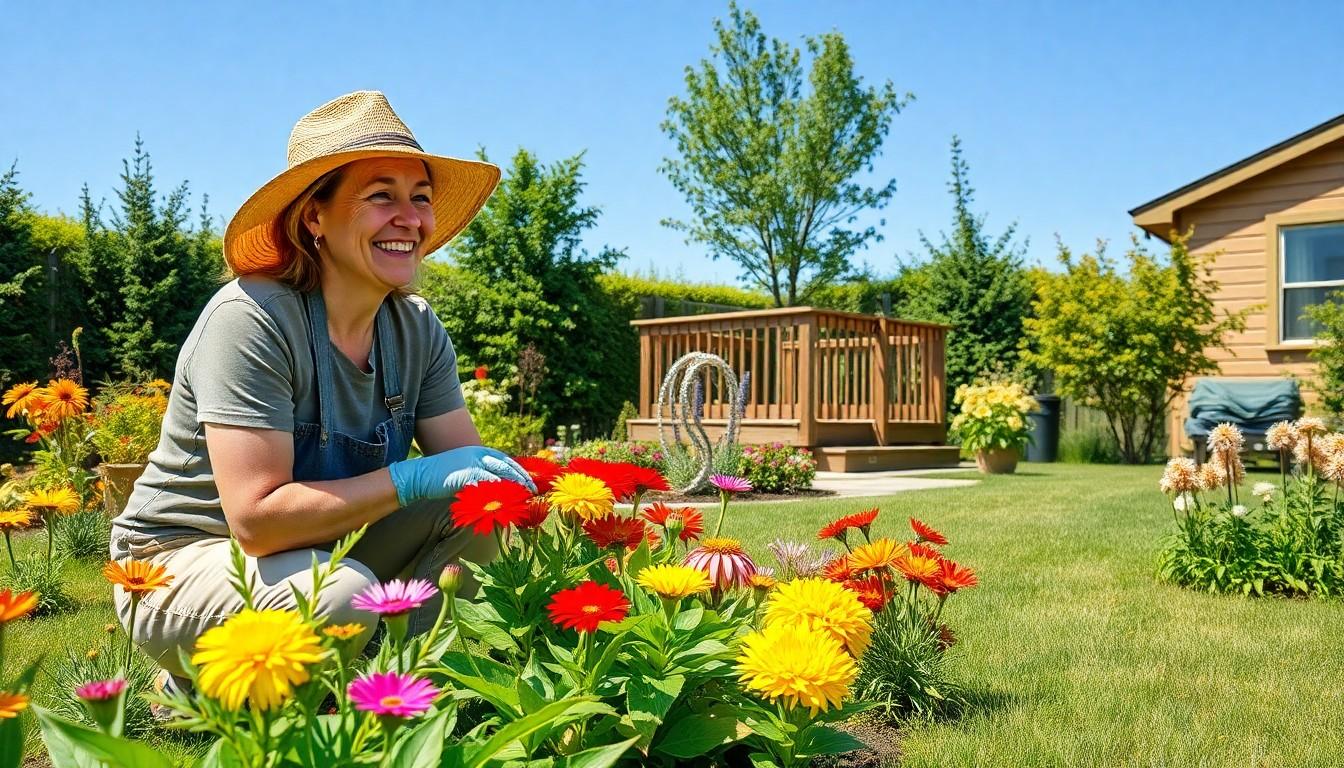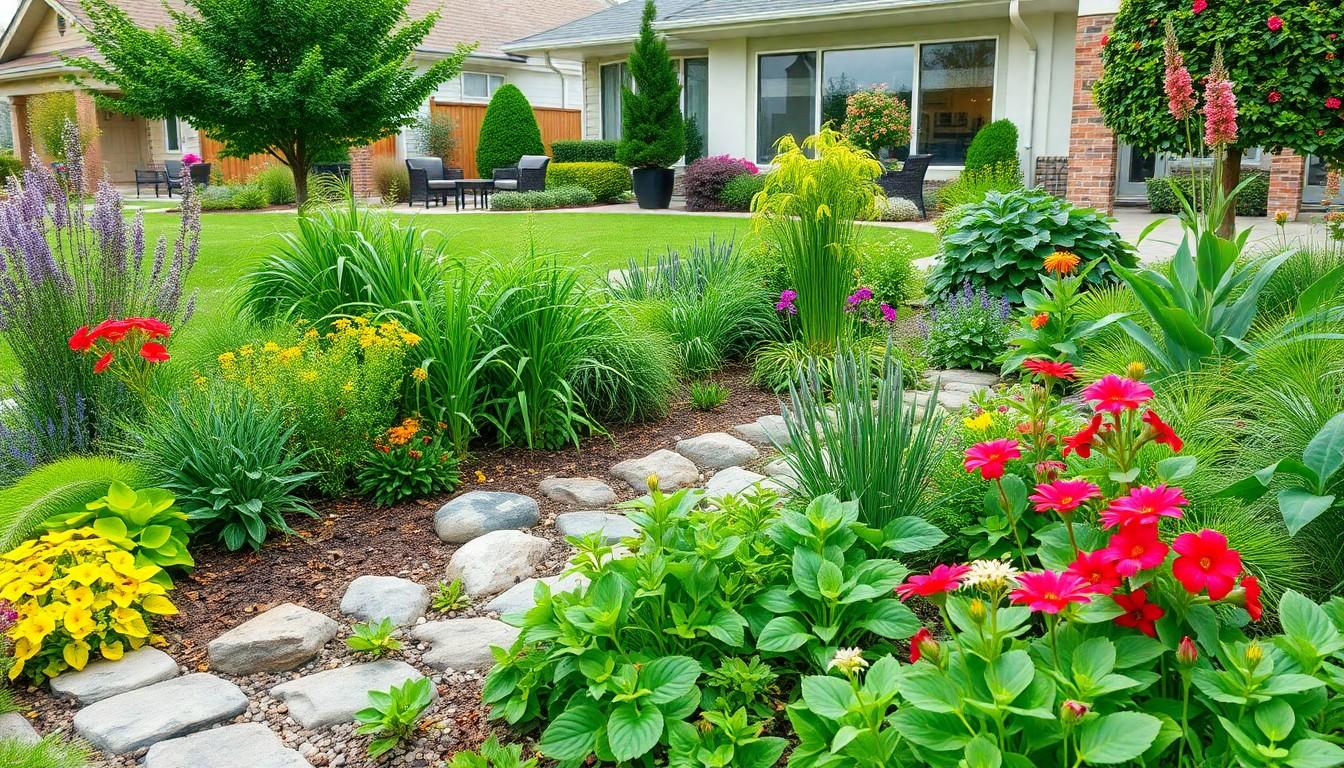Phone:
(701)814-6992
Physical address:
6296 Donnelly Plaza
Ratkeville, Bahamas.

In a world where lawns are greener and flowers bloom brighter, green landscaping isn’t just a trend—it’s a lifestyle. Imagine transforming your yard into a vibrant oasis while saving the planet, one shrub at a time. Who knew that planting native grasses could make you a hero in your neighborhood? Not to mention, your water bill might just thank you for it.
Embracing green landscaping means more than just a pretty yard. It’s about creating a sustainable environment that attracts pollinators, reduces waste, and even boosts property value. So why not trade that thirsty lawn for a lush, eco-friendly paradise? Your future self—along with the bees and butterflies—will be grateful. Let’s dig into the world of green landscaping and discover how to make Mother Nature proud while keeping your neighbors green with envy.
Green landscaping focuses on sustainable practices that enhance outdoor aesthetics while promoting environmental health. This approach prioritizes native plants, which require less water and maintenance, making them ideal for eco-friendly designs. Homeowners achieve reduced water bills through the installation of drought-resistant grasses and shrubs. Additionally, incorporating native species creates habitats for pollinators, such as bees and butterflies, contributing to local biodiversity.
Landscapers often advocate for minimizing chemical use in favor of organic alternatives. Organic fertilizers and pest control methods promote soil health and protect surrounding ecosystems. Sustainable landscaping techniques, such as rain gardens and permeable pavers, manage stormwater effectively, reducing runoff and preventing erosion. Design choices also play a crucial role; incorporating features like green roofs and living walls further enhances a property’s eco-friendliness.
Creating a vibrant outdoor space doesn’t require sacrificing beauty. Edible plants, such as herbs and fruit-bearing trees, add functionality while providing fresh produce. Focusing on local materials for hardscape elements decreases environmental impact through lower transportation emissions. Ultimately, green landscaping aligns aesthetics with sustainability, attracting potential buyers and increasing property value.
Investing in this eco-friendly approach benefits individual homeowners and fosters a healthier environment. The integration of sustainable practices into landscaping designs creates a legacy of conservation that future generations can appreciate. By prioritizing green landscaping, individuals contribute to a more sustainable future, making every outdoor space a vibrant and essential part of the ecosystem.

Green landscaping presents numerous advantages that extend to the environment, economy, and aesthetic appeal of outdoor spaces. It prioritizes sustainable practices while enhancing quality of life.
Implementing green landscaping significantly reduces water usage. Native plants thrive in local environments, requiring minimal irrigation and maintenance. Pollinator populations thrive with the inclusion of these plants, fostering local biodiversity. Hazardous chemical inputs are minimized, promoting healthier ecosystems. Additionally, green landscaping practices like rain gardens effectively manage stormwater runoff, reducing erosion and water pollution. Such measures contribute to a cleaner environment for all.
Investing in green landscaping leads to lower utility expenses. Reduced water consumption decreases monthly bills for homeowners. Properties with sustainable gardens command higher market values, attracting environmentally conscious buyers. Using local materials in hardscaping reduces transportation costs. Potential tax incentives for green landscaping projects can also provide financial relief. Overall, the initial investment pays off in long-term savings and increased property worth.
Green landscaping enhances the visual appeal of any property. Native plants create vibrant, colorful displays throughout the seasons, enriching outdoor environments. Incorporating features like living walls and green roofs adds unique elements that draw interest. The diverse textures and forms of plants contribute to an inviting atmosphere. Neighbors and passerby appreciate the lush landscapes, fostering community pride. Ultimately, a well-designed green space elevates the overall character of a neighborhood and supports environmental goals.
Green landscaping employs various techniques and practices to maximize sustainability while enhancing outdoor spaces. These methods focus on ecological benefits and aesthetic value.
Selecting native plants significantly enhances local biodiversity. By choosing flora native to the region, homeowners attract local pollinators, such as bees and butterflies. These plants typically require less water and maintenance, leading to lower irrigation costs. Some popular native options include coneflowers, black-eyed Susans, and grasses like bluestem. Incorporating these species creates a robust habitat that supports wildlife while providing vibrant seasonal displays. Cultivating native plants also reduces reliance on chemical fertilizers and pesticides, promoting soil and ecosystem health.
Implementing effective water conservation methods contributes directly to sustainable landscaping. Techniques like drip irrigation deliver water precisely to plant roots, minimizing waste. Rain barrels collect and store rainwater for garden use, effectively reducing water costs. In addition, xeriscaping encourages the use of drought-resistant plants, which thrive in dry conditions. Mulching around plants helps retain moisture in the soil, cutting down on irrigation needs. Integrating these conservation strategies not only lowers water bills but also fosters a resilient landscape that endures extreme weather.
Practicing sustainable soil management yields healthier gardens and landscapes. Techniques such as composting enrich the soil with organic matter, enhancing nutrient availability. Cover cropping also prevents erosion and promotes soil structure, improving its overall health. Utilizing organic mulch suppresses weeds, retains moisture, and enhances soil quality. These practices reduce the need for synthetic fertilizers and chemical amendments. Testing soil regularly helps assess nutrient needs and informs appropriate actions. Together, these sustainable approaches create a fertile environment that supports thriving plant life.
Green landscaping faces several challenges that can hinder its implementation. Environmental factors, maintenance needs, and resource availability impact efforts to create sustainable outdoor spaces.
Climate fluctuations affect the success of green landscaping initiatives. Local climate patterns influence plant selection and growth rates. Extreme temperatures, droughts, or excessive rainfall can create stress for native plants, disrupting their ability to thrive without additional care. Adapting plant choices to local conditions ensures better resilience. Unpredictable weather events may also lead to increased maintenance requirements. Therefore, choosing climate-adapted species aids in reducing long-term care and resource input.
Maintenance demands for green landscaping can challenge homeowners. While native plants often require less upkeep than traditional lawns, certain species still need ongoing care. Regular tasks, such as pruning or weeding, may arise, depending on the specific plants chosen and their growth habits. Efficiently managing water through rain gardens and drip irrigation systems offers solutions but requires initial investment in setup. Balancing effort and investment with desired aesthetics is key. Understanding individual plant needs further streamlines maintenance practices, ultimately creating a flourishing landscape.
Emphasis on sustainable practices continues to shape green landscaping. Innovations in native plant usage are expected to rise. Smart irrigation systems will become commonplace, enhancing water efficiency and reducing waste. Utilizing xeriscaping techniques gains traction as homeowners seek drought-resistant options.
Integration of technology in design plays a significant role in future landscapes. Mobile applications that assist in plant selection and care will simplify maintenance and promote eco-friendly choices. Furthermore, the use of drones for monitoring landscapes offers a novel approach to managing sustainability. These devices can provide insights into soil health and water needs.
Vertical gardens and living walls are gaining attention for maximizing space in urban areas. They create green environments while improving air quality. Community engagement in landscaping initiatives fosters a sense of responsibility and pride among residents. Collaborations among local governments, organizations, and homeowners aim to transform neighborhoods into greener spaces.
Adopting permaculture principles will likely see increased popularity. This holistic approach promotes biodiversity and ecosystem health while yielding food and resources. Incorporating edible landscaping is another trend, turning gardens into productive spaces that serve both aesthetic and functional purposes.
Focus on environmental resilience drives trends toward climate-adapted plants. Utilizing species that thrive in specific local climates ensures long-term sustainability. There’s greater awareness of the importance of pollinator habitats, leading to the advocacy for flowers and plants that attract bees and butterflies.
Finally, increased interest in sustainable hardscaping materials guides homeowners to select eco-friendly options for pathways and patios. Recycled materials and permeable pavers reduce environmental impacts and improve stormwater management. By embracing these trends, homeowners contribute to greener, more resilient landscapes.
Embracing green landscaping is more than just a trend; it’s a commitment to creating sustainable and beautiful outdoor spaces. By choosing native plants and eco-friendly practices, homeowners not only enhance their property’s aesthetic appeal but also contribute positively to the environment.
This approach fosters biodiversity, conserves water, and reduces reliance on harmful chemicals. As communities grow increasingly aware of environmental issues, the demand for green landscaping will only rise.
Investing in these practices today ensures a healthier planet for future generations while adding value to homes. With creativity and care, every yard can become a vibrant part of the ecosystem, showcasing the beauty of nature.